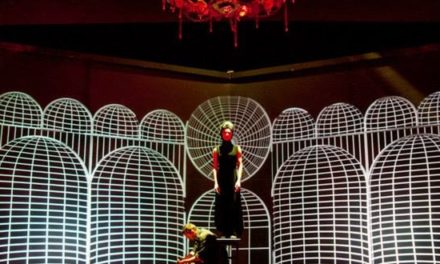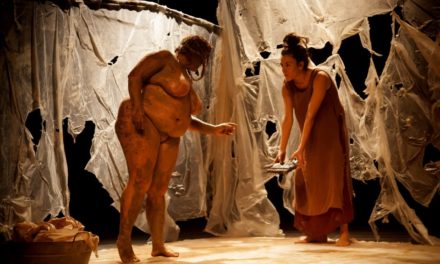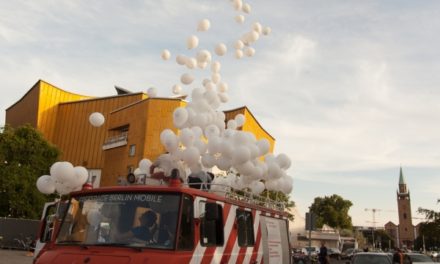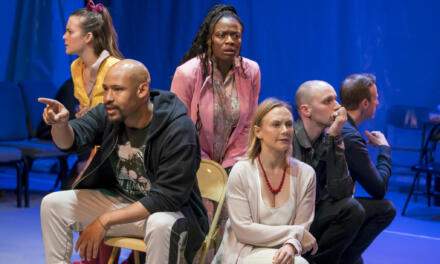Everything started to me in 2007. Since then it is me and her work, through her work, from her work. Now I write with her, with them, through her, through them from her, from them. Her: Eleonora Fabião. Them, together: Eleonora and her actions. Them together in an inextricable game: Eleonora’s Fabionic Actions.
Eleonora is a performer and theorist of performance art; she is a person and a professor, mother and sorceress; she is everything mixed because she sees the real things in the mixture. She is the one who once came to me with this word, a word that never left me: “inextricability.” Eléo, as I call her, is so much about encounters that what you get from her is the encounter itself and not her name. Her personality becomes invisible not because it fades out but because it transforms itself into experience exchanged with two people or three or with the city, with the streets and the adventure of performance with thinking and thinking that performs, making things happen. Her writings travel through e-mails and hands, among Brazilians and people from other countries, her writings, her thoughts about performance art and theatre, about the body and precariousness, about responding to the world through actions which, not killing or dying, make way for the blooming of new possibilities trough difference and strangeness.
It was 2007 when I was a graduation student in Theatre Staging at UFRJ (Federal University of Rio de Janeiro) and took a class with Eleonora called Post-War Experimental Scene. There, once a week, I discovered words that until today don’t stop revealing new meanings, I heard stories of man and women who made things happen in the world, involving themselves and others. I discovered performance art and dramaturgy, and I rediscovered what theatre could be.
It was 2015, in Rio de Janeiro, precisely on a Saturday, December, 12th. At a crossroad downtown, Eleonora had put chairs on the street in a kind of circle. In the center of this circle, there were glasses of water. There was also a rectangular table as well as many editions of Actions.
Fabião’s book has a yellow cover. It has been sponsored by Rumos Itaú Cultural 2013/2014 as part of Projeto Mundano (Mundane Project) proposed by her and Andé Lepecki, who organise the book together. In Actions, there is a chronology of the actions she performed between 2008 and 2015, not only in Rio but also in Berlin, Bogotá, New York, Fortaleza, São José do Rio Preto, Montreal and Santo André. Seven collaborators were invited to write articles for the book without the obligation to approach Fabião’s work. They were supposed to be written with her work, through her work, from her work, as the organisers say.
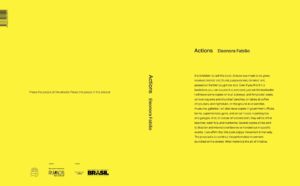
Book cover in English
Actions, Fabião’s yellow book, was printed in 1.000 copies (700 in Portuguese, 300 in English). A small edition, one might say, if it was not for the note on its cover saying it is forbidden to sell the book, for it was made to be “given, received, traded, lost, found, purposely lost, donated, lent, passed on.” Her game goes beyond the cover and contents. It is a game to be played with our hands, a game that implies and multiplies. Its weight cannot be measured in pounds nor can its extension be measured in inches. Everything about it has been made to become an experience again.
That December, among other people present at the book launch in Rio, I got a copy of it. It was Saturday, and many collaborators were in an engaged conversation. And then, when we were all leaving, there was a hard rain. A storm. A long while later I read the chapter dedicated to Carioca Action #8, called Storm, which did not happen then, in 2008, for in the day Eleonora prepared to perform it, the storm didn’t show up. But we are now talking about 2015, and there was a hard rain that Saturday. We were in a small group of people: me, André, Eleonora and their daughter Valentina, as well as collaborators Felipe Ribeiro and Pablo Assumpção, heading Ribeiro’s place to continue the conversation that bloomed in the book launch. We were assaulted by the storm. The group split, the books were dripping wet, streets were like rivers and an action that was supposed to take place in 2008 happened as an encounter in 2015, although modified.
At our friend’s house, we took turns with the soaked yellow books in the electric oven. It was like waiting for the next batch of bread. This book has a smell, yeast, and taste. A sustenance book. There is no need to charge its battery in a power plug. It has endless battery: it is solar. It craves for encounters, it wants to go out dancing, it wants to be lost to make us meet.
Some days after the book launch, I met in Rio a great friend of mine who is now living in the US. I left the house carrying my baked volume of Actions. The pages were a little damaged, the cover was a little harmed, it was dry but still alive although somewhat wounded by the storm. I put it in a plastic bag and gave to my friend, saying “Take these actions for a ride in the US.” It was an edition in Portuguese. There are some in English. But I believe it is not about the written language. It is about the encounter some hands and eyes will have with this brick that can compose and recompose streets, buildings, cities, and citizens.
My book is gone. I don’t have it anymore. It was not mine. But it is fine. The yellow book by Eleonora Fabião is not consumption goods. But then I was asked to write about the book and I asked a few friends if anyone could lend me a copy. Now I have with me a book that belongs to a friend. It has a written dedication to Thaís, but its encounter is with me now.
It was 2007 when Fabião and some students were talking about the entry “dramaturgy” in A Dictionary of Theatre Anthropology: The Secret Art of the Performer by Eugenio Barba and Nicola Savarese. We were talking about the notion of dramaturgy, which is expanded and goes beyond the written and spoken words to become the work of actions in performance. Dramaturgy is the work of actions and action, as suggested by the authors, it is everything capable of acting not only on the spectator’s attention but also on its understanding, its emotions, and synesthesia.
I believe Actions, as it is a reliquary of its performative actions, is also a way to rethink dramaturgy. It is a way to think about the urgencies of actions. Her actions are not only hers but also and mostly of the ones who experience them. It is about composing with someone else, composing through. It is about her, me, you and the city. It is about us who are born of the encounters with each other. It seems to me that the publication of this yellow book by Eleonora Fabião is a concatenation of simultaneities, encounters, affections, unexpected and planned and unexpectedly planned. Since it is a book on the simultaneity of these actions (as it moves us and guides our attention), it is also a book that invites us to experience.
There are seven authors: Adrian Heathfield, André Lepecki, Bárbara Browning, Diana Taylor, Felipe Ribeiro, Pablo Assumpção B. Costa and Tania Rivera. They write the seven essays of the book, as seven offerings, seven works of extraction. Trough their essays they talk to her to reach the reader. It is a book that studies an artist and by doing that it makes us study and rethink our world. They are more intimate writing than one may think and perhaps because of that they show us the foundations, what lives within, under the ground, inside the gesture, the words, and a simple action. Pablo Assumpção B. Costa says “Here is an artist that does not do a performance (to be seen), but she perpetrates it (so we can deal with its effects).”
Her actions challenge our reality making us experience the world and ourselves again. Having an experience is something with flavor. She changes clothing, the duration of things; she tampers with colonial colors to stamp acrylic paint. Her book announces the program of each action, sharing photos and fragments of notes, her thinking, and her diary. Actions are actions with echo in the movement of the one who reads – and writes together – the book.
Only now, as I am writing this text, I realize a possible reason for the yellow color. From the Greek “pales,” pollen is the grain that fecundates cells that are going to become seeds. Eleonora Fabião is pollen. And Actions is her pollen book, a reliquary of acts that invites the reader to other blossomings. Some people are inclined to polemics. That is not the case. Eleonora Fabião is inclined to pollinate. Let us spread these seeds, let us spread her Actions!
This post was written by the author in their personal capacity.The opinions expressed in this article are the author’s own and do not reflect the view of The Theatre Times, their staff or collaborators.
This post was written by Diogo Liberano.
The views expressed here belong to the author and do not necessarily reflect our views and opinions.


